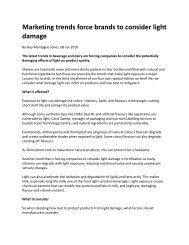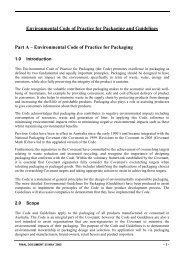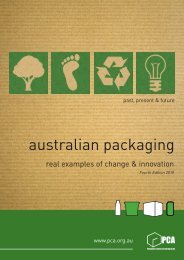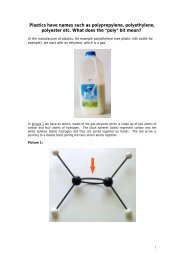Food labelling guide - the Packaging Council of Australia
Food labelling guide - the Packaging Council of Australia
Food labelling guide - the Packaging Council of Australia
You also want an ePaper? Increase the reach of your titles
YUMPU automatically turns print PDFs into web optimized ePapers that Google loves.
that <strong>the</strong> business does not make any representations on <strong>the</strong> product’s <strong>labelling</strong>, packaging or<br />
advertising likely to mislead a consumer into believing that a particular ingredient is prominent<br />
when it is not.<br />
Words, images and <strong>the</strong> overall impression<br />
When a business makes a representation about a food product, it must ensure <strong>the</strong> overall<br />
impression <strong>of</strong> <strong>the</strong> representation is not misleading or deceptive. Many factors influence<br />
whe<strong>the</strong>r an ingredient is predominant in <strong>the</strong> class <strong>of</strong> ingredients present and whe<strong>the</strong>r<br />
statements about <strong>the</strong> ingredient may be misleading. These factors rely on <strong>the</strong> overall<br />
impression conveyed through <strong>the</strong> words, images and general ‘get up’ <strong>of</strong> a product’s <strong>labelling</strong>,<br />
packaging and promotional material. An audience may be misled by emphasis on different<br />
aspects <strong>of</strong> <strong>the</strong> representation or by mistaken—but understandable (and uncorrected)—<br />
assumptions and preconceptions.<br />
For example, if a business uses an image <strong>of</strong> a rare and delicious ingredient on its new product<br />
label, minor ingredients should not be given a disproportionately large pictorial emphasis<br />
because this is likely to mislead consumers.<br />
The ACCC assesses each matter on a case-by-case basis. For example, particular care<br />
needs to be paid to <strong>the</strong> <strong>labelling</strong> <strong>of</strong> new products that consumers may be unfamiliar with,<br />
while traditional associations and familiarity with a product may lead consumers to make<br />
assumptions or apply preconceptions because <strong>of</strong> <strong>the</strong> overall impression given by <strong>the</strong> <strong>labelling</strong>.<br />
examples<br />
In April 2008 <strong>the</strong> Federal Court declared (by consent) that <strong>the</strong> packaging <strong>of</strong> a number<br />
<strong>of</strong> Arnott’s Biscuits Ltd’s Snack Right products, including Snack Right Apple and<br />
Blackberry Fruit Pillow and Snack Right Apricot Fruit Slice falsely conveyed a particular<br />
overall impression. The court declared <strong>the</strong> packaging falsely conveyed an overall<br />
impression that <strong>the</strong> filling in <strong>the</strong> biscuits consisted predominantly <strong>of</strong> <strong>the</strong> fruits referred<br />
to in <strong>the</strong> product name and on its packaging when in fact <strong>the</strong> filling mainly consisted <strong>of</strong><br />
o<strong>the</strong>r fruits. For example, <strong>the</strong> Apple and Blackberry Fruit Pillow filling only comprised<br />
around 1.7 per cent blackberry concentrate, along with almost 40 per cent sultanas,<br />
12.9 per cent apple concentrate and 8.6 per cent dried apple concentrate. In <strong>the</strong><br />
Apricot Fruit Slice filling only 1.7 per cent was apricot, while 64.8 per cent was sultana.<br />
8 <strong>Food</strong> <strong>labelling</strong> <strong>guide</strong>













